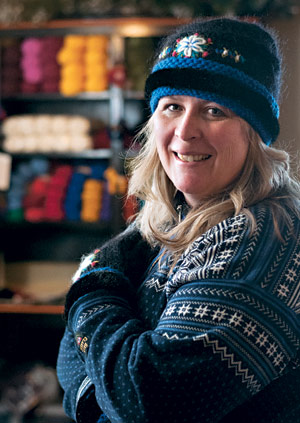KILA – When Mette Cephers knits, there’s a strand of history that intertwines with her Iceland wool yarn. Her pieces are made with an old pattern from 1890s Sweden, one that was favored by lumberjacks and princesses alike, but there’s also a sense that each creation fits into modern times seamlessly.
The knitted items, which make up the inventory for Cephers’ business, SNÖ, have proven as popular in the Flathead and the rest of the country now as they were in late-19th century Scandinavia.
Cephers said last year’s business was “fabulous,” and this year she’s having trouble keeping up with demand for her mittens, hats and headbands. Each is handmade, with Cephers employing four other knitters to help her with the bulk work. Each piece is finished by either Cephers or her mother, Emy Amy.
“They’re done the true, craftsman, artisan way,” she said last week in her Kila workshop, which doubles as her family’s basement.
SNÖ stands for Scandinavian Natural Outerwear, and Flathead Valley residents may recognize it from shopping in Sportsman & Ski Haus in Kalispell and Whitefish or the Toggery in Whitefish.
Two years ago, Cephers began selling SNÖ merchandise at Sportsman, and they would call each week for more. Last year, the sporting goods store bought out her entire inventory at one point, she said.
“Sportsmans has been my flagship store,” she said.
SNÖ also went national in 2013, with Cephers selling her outerwear in 21 different stores across the country. This year, her work is also going international, since she has sent Whitefish’s Olympic skier Maggie Voisin’s family to the Sochi Olympics with SNÖ gear.
Cephers’ knitted creations are made using a pattern from Sweden in the 1890s. According to Cephers’ mom, a lumberjack asked his wife to make him some sturdy, warm mittens he could work in, and she came up with this tight pattern made from hardy, thick wool.
In the 1930s, a Swedish businesswoman gave some knitted pieces made from this pattern to a Swedish princess, who wore them on a ski tour.
Cephers adorns her weather-ready woolen outerwear with flowers, fur and even Swarovski crystals. The wool, which she imports from Iceland, is the key to harnessing warmth and keeping out the cold, all without the itch wool can cause.
“I want to educate people that (wool) functions as well as looking beautiful,” Cephers said. “People need to trust it again.”
Learning to knit was part of Cephers’ upbringing as one of six kids on her family farm in Colorado. Her Scandinavian history – her father immigrated to the U.S. from Denmark and her mother’s family came from Sweden – and the self-sustaining nature of the farm meant learning practical skills.
As she grew up, Cephers mastered needlework, which kept her busy during her first year as a dispatcher for the fire department on the base at McMurdo Station, Antarctica, in 1995.
But as she prepared to head back for her second year on the job, Cephers implored her mother for another crafting idea, since needlework had lost some of its luster.
Her mother, being a Scandinavian folk artist, suggested the knitting pattern Cephers uses now. While in Antarctica, she knitted hats and mittens for her friends, and she kept notebooks full of names of people who wanted her handiwork. She still supplies the necessity shops at the three United States Antarctic research stations.
“They’re tested in the coldest, harshest climate in the world,” Cephers said of her knitwear.
One friend received a hat in 2001 and is still wearing it, Cephers said. Wool has a long life, even if it is put through rigorous treatment; friction and time turn wool into felt, which makes it even softer and more wind-resistant, she said.
Cephers still wears a pair of mittens she made more than 10 years ago, and uses them for everything from skiing on Big Mountain to hauling firewood.
 |
|
Mette Cephers, founder of Sno, shows off her wool hats and mittens. – Greg Lindstrom | Flathead Beacon |
“This brand, I want to build it on being functional as well as looking great,” she said.
A pair of SNÖ mittens costs $99, hats are $129 and headbands are $49. People might balk at the high price points, Cephers said, but then they realize the pieces are a one-time purchase, unlike other gloves or hats that may fall apart after a few seasons.
As for the Voisins, when Cephers found out Maggie had made it to the 2014 Games for slopestyle skiing, she immediately wanted to honor Maggie’s parents, Truby and Kristin, for all their hard work behind the scenes of their daughter’s success.
Cephers and her mother whipped up four sets of hats and mittens for Maggie’s parents, and each of her grandmothers.
“I mostly wanted to honor the mothers,” Cephers said.
In the fall, Cephers hopes to unveil a line of knitwear for men and boys, and as her business grows she will keep production in the United States while using Scandinavian materials.
But until then, each piece will be made by a tight-knit circle of folks in Kila, overseen by Cephers and her mother. There’s no sense in fixing what already works.
“I was raised to be very practical,” Cephers said.
For more information on SNÖ, visit www.snomontana.com.